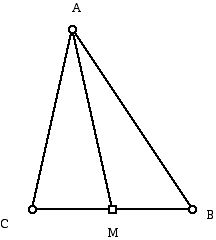
Triangle Centers
Prepared by:
Joseph Malkevitch
Department of Mathematics
York College (CUNY)
Jamaica, New York 11451
email:
malkevitch@york.cuny.edu
web page:
http://york.cuny.edu/~malk
Given a triangle there are lines associated with the triangle, whether one is talking about a triangle in the Euclidean plane or the Taxicab plane, which are of importance for historical and practical reasons. These lines include the median, altitude, perpendicular bisector of a side, a perimeter bisector, and angle bisector. My goal here is to briefly call attention to these lines and some of their properties.
Figure 1 shows a typical triangle ABC in the Euclidean or Taxicab plane.

Note this particular triangle is an acute angle triangle but one of the angles might be an obtuse angle. One could also have a right triangle where one of the angles of the triangle is a right angle. No triangle in the Taxicab or Euclidean plane can have two right angles or two obtuse angles. This is because in these planes the sum of the angles in a triangle is 180 degrees. What is shown in Figure 1 is a line segment AM joining vertex A to the midpoint M of the side BC of the triangle. The line segment AM is known as the median from vertex A to the opposite side, in this case CB. A triangle has three medians, one from each vertex to the side opposite it. The medians of a triangle intersect in a single point which is the centroid of the triangle. If one supports a triangle and its interior with a pencil point at the centroid, it will exactly balance (but be in unstable equilibrium).
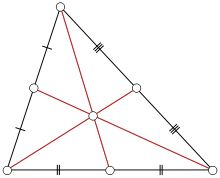
Although the median is treated as a segment, it is often convenient to think of this segment as being part of the infinite line which contains this segment. The same can be said for the other lines we will shortly define. The centroid will always be an interior point of the triangle, though this will not always be true for the other special points which we will shortly discuss. Also, the centroid point lies 2/3 of the way from each vertex to the midpoint of the opposite side along the median line.
Another collection of important lines for a triangle are the perpendicular bisectors of the sides of the triangle. In Figure 1 we can draw a line through M which is perpendicular to the side BC of the triangle. The points on this perpendicular bisector are equidistant (Euclidean distance) from the points B and C. Similarly, there are two other lines which are the perpendicular bisectors of the sides of AC and BC. These three lines meet in a single point O, which does not necessarily lie in the interior of the triangle (for an obtuse triangle the point is outside the triangle and for a right triangle it lies at the midpoint of the hypothenuse of the triangle). The point where the perpendicular bisectors of the sides of a triangle meet is the center of a circle which passes through the vertices of the triangle. This circle is known as the circumcircle for the triangle. Since, in general, three points not on a straight line form a triangle, if one wants to find a circle which passes through the three points, one can find such a circle by finding the point O where the perpendicular bisectors of the sides meet, using as the radius of the circle the distance from O to any of the three points.
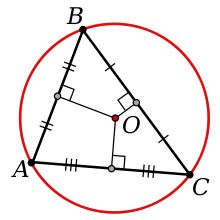
Another surprise concerns the altitudes of a triangle. (It is convenient here to think of an altitude as a line rather than a segment.) Given the vertex A of triangle ABC we can draw a line through A perpendicular to the side opposite A, BC as in Figure 4. Sometimes it is necessary for the side BC to be extended beyond vertices B and C for this perpendicular line to intersect the opposite side. This happens in the case where the angle at B or C is obtuse. (If the angle at B or C is obtuse, then A must be an acute angle since there can be no more than one obtuse angle in a triangle.) The point where the three altitudes of a triangle meet is called the orthocenter of the triangle (Figure 5).
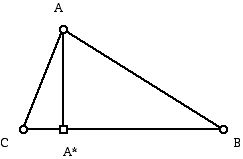
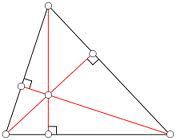
Given a triangle, one can bisect its interior angles. The resulting lines are called the angle bisectors; they are concurrent at a single point. If one takes a point on an angle bisector at vertex A and drops a perpendicular to the sides of the triangle that meet at A, one gets two equal (Euclidean distance) length segments. The point where the three angle bisectors meet is the center of a circle which will be tangent to the three sides of the triangle. This circle is known as the incircle of the triangle (Figure 6).
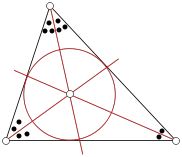
All of these situations create a certain sense of "wonder" because perhaps the fact that the lines involved are concurrent is unexpected. Historically, these special points were known to the Greek geometers, except for the orthocenter. The first proofs of the concurrency of the altitudes seems to date from the 18th century.
A general tool for proving concurrency of lines through the three vertices of a triangle is usually attributed to Giovanni Ceva (1647-1734).
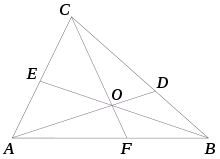
Ceva's Theorem states that the lines CF, AD, and BE are concurrent at O if and only if the lengths of the segments obey: (AF)(DB)(CE) = (FB)(DC)(EA). (Sometimes the theorem is stated in terms of directed line segments.)
Reference:
Coxeter, H. S. M. and S. Greitzer, Geometry Revisited, MAA, Washington, 1967.